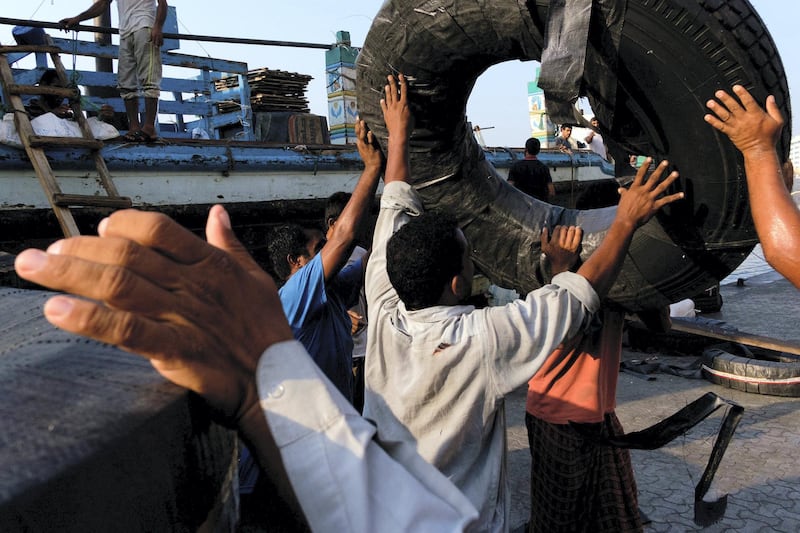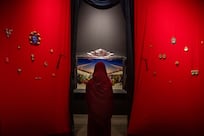A group of men squat low over the pavement as they inspect a pile of shining rings that are displayed on a man’s crisp, white ghutrah.
A boy appears momentarily horizontal, mid-way through an acrobatic back flip, while on a wintry and wave-lashed beach a teenager sits astride his BMX. Ignoring the pony-riding youths that surround him, he focuses instead on a spotted dog that’s digging deep into the sand.
The images, each of which adheres in its own way to the photographer Henri Cartier-Bresson’s notion of the “decisive moment” but each of which are also ostensibly banal, represent three snapshots of everyday life in the Arab world – in Saudi Arabia, Tunisia and Morocco – not as it is depicted in newspaper headlines but as it is experienced on the ground.
Captured by Yoriyas Yassine Alaoui Ismaili, the beach picture is part of a series, Casablanca, Not the Movie, through which the Moroccan photographer hopes to encourage viewers to "leave the black-and-white Humphrey Bogart, Rick's Cafe, and breathy declarations of love to instead visit the real Casablanca". Alaoui Ismaili's images explore Morocco's biggest city, capturing streets and scenes he describes as simultaneously chaotic and organised at "perfect moments" when various layers of activity fall briefly in sync.
“I am looking for an unexpected moment which can happen only once. Through one photograph, we can possibly see, enjoy, ask questions and care more about a scene that we probably wouldn’t have noticed if it wouldn’t have been captured,” the photographer explains on his website. “This project documents such moments of contrast in order to give a close and personal view of Casablanca life from the perspective of a Moroccan, who was born, grew up and still lives there.”
That combination of the quotidian and the extraordinary has earned Alaoui Ismaili's image a place in the new street photography exhibition, The Arab Street, which is about to open at Dubai's community-focused photography centre, Gulf Photo Plus. The show has been curated by GPP's gallery manager, Miranda McKee, with two aims in mind: overturning stereotypes and providing something of an antidote to the kind of images that have come to define the region; and encouraging UAE-based photographers to take to the streets themselves.
“What better time than now to portray everyday life from a region too often misrepresented through imagery?” says the Canadian curator.
“Instagram feeds like Everyday Middle East do a wonderful job but unfortunately that’s not what people think internationally because they don’t get to see everyday life here.
“All they get to see is what makes the front page of the newspaper, and while we don’t want to deny that’s the case, that’s not the whole truth.”
Timed to coincide with GPP's forthcoming Street Week, a series of Fujifilm-sponsored workshops and events, The Arab Street follows on from a previous, internationally-focused street photography show that was held at GPP. It features the work of 35 photographers, each of whom were approached specifically, often with specific images in mind.
“We were looking for a variety of perspectives so we reached out to photographers that we knew would give us that,” says McKee.
These include several images taken locally, such as Sreeranj Sreedhar's picture of a truck being loaded at Dubai Creek, Joey Reginaldo's shot of young, shalwar kameez-clad boys playing football, and Cheerleaders by Silvia Razgova, all of which point to the UAE's ethnic diversity.
Another local image, Sincere Love by Ola Allouz, is informed less by Bresson's notion of the "decisive moment" and more by William Eggleston's commitment to finding beauty and meaning in the things and places that other people find commonplace or even ugly, an aesthetic that has overtaken Cartier-Bresson's since it first emerged in Eggleston's Guide, the catalogue to the photographer's controversial show that was mounted at the Museum of Modern Art in New York (MoMA), in 1976.
In many ways, Allouz’s image represents the new default for what passes as contemporary street photography, which is perhaps not surprising considering her role in the UAE’s burgeoning street photography scene. Based in Dubai, Allouz curates the foto.UAE Instagram feed, which also acts as a platform for other UAE-based street photographers such as Hussain AlMoosawi, who has built a considerable following thanks to his carefully composed images of colourful construction hoardings, UAE national flags and old fashioned air-conditioning units.
For McKee, it is this kind of intense observation, rather than Cartier-Bresson’s ability to capture a fleeting moment of compositional poetry and brilliance, that makes street photography so important, especially in the current moment.
“Street photography can be in some ways the most challenging type of photography but it can also be the most accessible, and whether you are a hobbyist or not, you can pursue street photography on your own,” the curator explains.
“The people I speak to who do street photography regularly are much more aware of their surroundings and I think it’s more important than ever now to pursue things like this to really connect with people again and to use the opportunity to start talking to people and to pay attention to what surrounds you.”
The Arab Street runs at Gulf Photo Plus, Dubai, from Thursday, December 13, to January 27. For more information, go to gulfphotoplus.com
_____________________
Read more:
[ Tate Modern retrospective offers visitors the chance to experience Modigliani’s Paris studio ]
[ V&A eyes new overseas projects, inspired by Louvre Abu Dhabi ]
[ Dr Karima Alshomely on the inspiration behind The Emirati Burqa exhibition ]
_____________________














